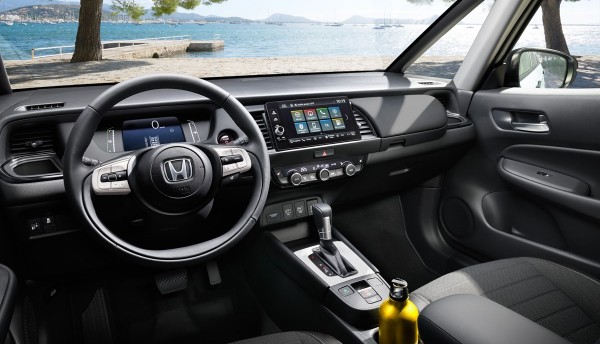
Honda has refreshed its fourth-generation Jazz and Jazz Crosstar, introducing a range of exterior and interior enhancements across all trims. This review delves into the new technologies and materials that elevate this popular supermini.
Inside story
The Elegance and Advance trims feature revamped black interior trim, now complemented by contemporary seat fabrics that enhance the overall esthetic.
In the Crosstar variants, the interior benefits from updated transmission tunnel edging and revised black water-repellent seat fabric. The cup holders at the dashboard's outer edges now feature a gloss black finish, harmonizing with the dashboard and door panel materials. Across all models, the gear switch collar trim has been upgraded to silver, while the door switch trim adopts a matte finish that aligns with other touchpoints. The Advance grades also introduce a frameless rearview mirror.
The Advance Sport grade stands out with a three-spoke steering wheel featuring yellow stitching and paddle shifters, enhancing its sporty character. It incorporates a blend of black and grey synthetic suede along with smooth synthetic leather, further accentuated by matching yellow stitching. Metal sports pedals complete the athletic esthetic.
Cabin space
From a practical standpoint, the Crosstar excels with a luggage capacity of 304 liters [10.7 cubic feet], expandable to 1,205 liters [42.5 cubic feet] when the rear seats are folded down. This versatility is enhanced by the strategic placement of the fuel tank beneath the front seats, facilitating the Magic Seat configuration. This allows for both flat and flip-up seating options, while the design features a wide tailgate opening and a flat floor, simplifying the loading of larger items.
The front seats use Honda's body-stabilizing seat frame technology, providing good support during drives. A higher seating position enhances visibility, which is particularly beneficial in towns. The standard reversing camera aids in parking, and the compact turning circle improves maneuverability in tight spaces.
The brake pedal position has been optimized for a more natural foot placement, contributing to overall driving comfort.
The rear seating area is particularly noteworthy, offering class-leading legroom that comfortably accommodates taller passengers. With 986 mm of rear legroom, this is made possible by the packaging of the rear suspension layout and e:HEV [hybrid electric vehicle] components. Revised seat padding ensures that two adults can sit comfortably in the back, providing ample knee room for taller occupants.
According to research by S&P Global Mobility, TS Tech is the primary manufacturer of seats for the Jazz, supplying seats for approximately 60% of Honda vehicles produced globally. This company has a long-standing relationship with Honda, providing various seating solutions that enhance comfort and support for drivers and passengers alike. Other suppliers such as Adient and Setex also contribute to the seating assembly for Honda models, but TS Tech remains a key player in this segment.
Infotainment and connectivity
The infotainment system is accessible via a 9-inch central touchscreen or voice activation. It enables users to manage various applications, including weather updates, parking locations, music playback, navigation and phone services. The LCD HMI [human-machine interface] touchscreen is designed to minimize driver distraction, featuring clearly defined tiles for each app alongside physical controls for essential functions.
The Jazz supports smartphone mirroring through Android Auto and Apple CarPlay, the latter now available via wireless connection for the first time in this model. In-car Wi-Fi connectivity further enhances the experience for occupants. The My Honda+ app allows drivers to access various in-car functions, including various convenience and security features.
Subscription packages
The Jazz offers subscription packages such as Core Connectivity, Safety and Journey, and In-Car Wi-Fi. The Core Connectivity package allows owners to enroll their vehicle within the app, enabling them to store key vehicle data and remotely lock or unlock the car from their smartphone. Users can also sound the horn to locate their vehicle in crowded parking areas. This package includes remote climate control, allowing drivers to preset interior temperatures before embarking on a journey.
Dealers can share digital health check results directly with owners through the app, while the eVHC [Honda electronic vehicle health check] platform facilitates communication with dealerships for necessary repairs or service requests. My Honda+ enhances security by offering location monitoring and GPS tracking, with intelligent geofencing capabilities that alert owners if the vehicle breaches a designated zone.
On balance, the Crosstar offers a practical and spacious interior, though it falls short in design and technological execution. The cockpit, while functional, lacks the modern appeal and intuitiveness that contemporary drivers expect. Connectivity features can be inconsistent, and the material quality may not satisfy those seeking a premium experience. While the Crosstar is a sensible choice for practical buyers, it may not meet the needs of those desiring a more refined driving experience. Although it balances functionality and comfort, there are areas for improvement that could affect its competitiveness in the market.
S&P Global Mobility’s latest report offers an in-depth analysis of current trends in the global automotive sunroof market. In addition, the report covers the growth outlook in key sunroof system markets, major suppliers that produce sunroofs, and automakers that offer sunroofs in their vehicles.








